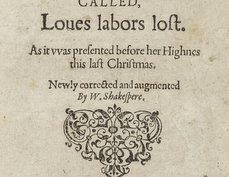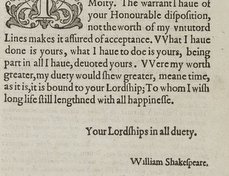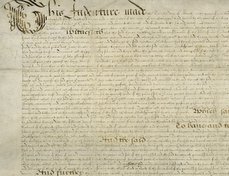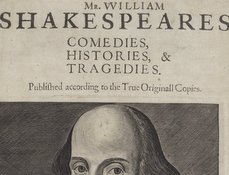Transcription conventions
Shakespeare Documented provides two sets of transcriptions for each manuscript: a semi-diplomatic transcription and a modernized or translated version. If the transcription, modernization, or translation is taken directly from another source, that source is noted.
For printed works, we do not transcribe title pages since this information is fully searchable through the bibliographic record. We also do not transcribe printed pages with manuscript marginalia: in those cases, we transcribe the manuscript marginalia only.We provide modernized transcriptions of all other printed pages.
Spelling in the early modern period was not standardized: it was not unusual for writers and type-setters to spell the same word in two different ways in the same line of text, or for an individual to spell his or her last name differently in various documents. The alphabet was also slightly different from our modern alphabet. The letter "j" was not part of the alphabet, so names like John and Joan were spelled "Iohn" and "Ioan," justice was spelled "iustice," etc. The letters "u" and "v" were used interchangeably, as in the word "vsed" (used) and "haue" (haue). Punctuation was inconsistently applied, and sometimes ignored. Sometimes a gap indicates a period mark, and a virgule (/) can indicate a paragraph, a comma, or a period mark.
Semi-diplomatic transcriptions of manuscripts
Semi-diplomatic transcriptions record as much of the detail of the handwritten or printed text as practical. This allows visitors to compare the transcriptions to the digital surrogates and to identify deleted text, emendations, abbreviated words that have been expanded, and other details.
Original spelling (including i/j, u/v, and ff), punctuation, capitalization, lineation, and indentation are maintained. Abbreviations are expanded with the supplied letters italicized and superscript letters silently lowered. Exceptions to the abbreviation rule are symbols for money (l, s, d), which remain superscript and abbreviated, and forms of address (Mr, Mrs), which also remain abbreviated since they were never expanded in the period. The orthography of the scribe is observed when expanding abbreviated words. Thorns (the medieval symbol for "th," typically rendered as a "y" in early modern print and manuscript) are replaced with italicized "th." Cancelled words are struck-through. Interlineal insertions remain superscript, and are marked by a caret symbol (^) if present. Indecipherable or obliterated words appear in square brackets with dots representing the number of letters thought to be missing. Accidental obliterations, flourishes, and line fillers are not represented in the transcription, but will be visible in the digital image of the manuscript. Changes in hand, ink, or size of script, are not indicated in the transcription.
Modernized texts
Modernized texts are easier to read than semi-diplomatic transcriptions because the spelling and punctuation are modernized and the lineation of the original document is not observed.









